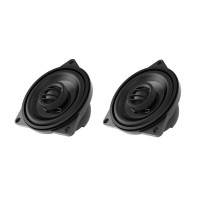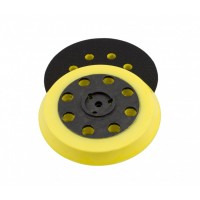Subwoofer in box Match PP 7S-D
subwoofer in box, 2 x Ø 6.5" (165 mm), 200 W RMS, 90 dB (SPL 2.83 V/1 m), 2 x 4 Ω
More about the product
More about the product
We will help you with your purchase
- Use our consulting room
- You can return the goods to us within 14 days
- Try the product at our store
Subwoofer in box Match PP 7S-D
A compact subwoofer for supplementing Plug & Play systems that fit exactly in your car. It is thus an ideal addition to Match amplifiers - e.g. PP 62DSP . You can choose from 3 types of subwoofers, it depends on your requirements for space in the trunk. These subwoofers are proof that even compact sophisticated enclosures combined with the most modern DSP technology can achieve deep bass. The secret of success lies in the teamwork of both "players". Match amplifiers have a precisely prepared channel for these subwoofers with optimal performance and settings. Subwoofers then have their coil impedance tuned to achieve maximum effect. The package also includes a connection cable (4.8 m) in a protective braid.
Key properties
- Extremely compact baffle - ideal for use in spare wheel wells.
- Optimized for MATCH Plug & Play amplifiers.
- Two 16.5 cm woofers with handmade paper diaphragm and double voice coil.
- Double ventilation of the oscillating coils.
- Powerful voice coils with large winding widths.
- The easiest connection option using a pre-assembled subwoofer cable.
- Massive metal grilles for optimal protection of the bass speakers.
| Catalog number | PP 7S-D |
| Brand | Match |
| Links | Official web presentation |
| RMS powerThe RMS power of the subwoofer is constant power. This is also the performance of continuous use of the subwoofer. If you exceed the power for a longer period of time, irreversible damage or subwoofer voice coil burning! You can tell if the subwoofer is overloaded by the vibration of the subwoofer membrane. | 200 W |
| Max. (maximum performancePeak performance , which the subwoofer can play momentarily (approx. 0.5 s), for example when hitting drums in a song. If the maximum power is exceeded, damage can quickly occur or subwoofer voice coil burning! | 400 W |
| The diameter of the subwoofer in the box | 2 x 165mm (6.5") |
| Sensitivity (SPL 1W/1m)Subwoofer sensitivity or efficiency. The sensitivity of the subwoofer is given in decibels (dB) and, in simple terms, means that the higher the value, the lower the demands on the power of the amplifier. This is a de facto rating of how a subwoofer converts watts to sound. Sensitivity ratings are in noise level measured at 1 meter from the subwoofer using 1 W (watt of power) or using 2.83 volts at the source at 1 meter. A higher decibel level means the subwoofer is louder with less power. For every 3 dB increase in sensitivity, the subwoofer requires half the power to reproduce the same volume. For example, if an 88dB subwoofer needs 300 Watts to produce a certain volume, then a subwoofer with a sensitivity of 91dB needs only 150 Watts to reach the same volume. | 90dB |
| ImpedanceImpedance - measurement of electrical resistance. When buying a subwoofer, it is very important that everyone make sure that the impedance is compatible with the amplifier that you are connecting to it. For subwoofers with a double voice coil, we recommend following the information in the advice center! Example: A 2 Ohm subwoofer cannot be connected to an amplifier that is only stable up to 4 Ohms. A 4 Ohm subwoofer can easily be used with an amplifier that is stable up to 2 Ohms. Connecting a 4 Ohm subwoofer to an amplifier that is stable up to 4 Ohms also without problems. The most common subwoofer impedance is 4 Ohm. Example: A 2 Ohm subwoofer cannot be connected to an amplifier that is only stable up to 4 Ohms! A 4 Ohm subwoofer can easily be used with an amplifier that is stable up to 2 Ohms. The most common impedance of subwoofers is 1 x 4 Ohm. | 2 x 4 Ω |
| Loudspeaker typeThe closed enclosure is characterized by a simple construction. Closed enclosures are usually smaller than bass-reflex enclosures, and a special damping fleece is used for their damping. A closed baffle has the advantage of preventing an acoustic short between the front and back radiation of the subwoofer diaphragm. The disadvantage is that the closed enclosure raises the natural resonance frequency of the used subwoofer and thereby also increases the lower limit frequency. This is because the back side of the diaphragm is forced to compress and dilute the air inside the enclosure when the subwoofer is radiating in a closed enclosure. This adds to the inherent stiffness of the subwoofer's oscillation system the stiffness of the air in the closed enclosure. This causes an increase in the stiffness of the oscillating system and thus an increase in the resonant frequency of the entire system: subwoofer -> loudspeaker. The increase in resonant frequency for a given subwoofer is greater, the smaller the volume of air in the closed enclosure. The relatively small volume of air in the closed enclosure acts on the subwoofer as an acoustic spring when radiating the back side of the membrane into the enclosed enclosure. USE: Mainly for quality bass listening in the entire band with an emphasis on detail and accurate reproduction in the lower band. Pros and cons: + pure reproduction + small closets + easier tuning - low level of efficiency in deep bass - loudness only at the cost of enormous deflection of the diaphragm - a significant acoustic pressure cannot be expected The bass reflex enclosure is designed in the same way as a closed enclosure, but it also has a so-called bass reflex mouthpiece, or "bass reflex". Needle foam is used to dampen bass reflex enclosures. USE: The ideal use is in cases where the listener wants to achieve a high volume and a good sound pressure level. It is the best compromise between sound quality and performance and is also the most commonly used Pros and cons: + good efficiency in deep bass + a small deflection of the membrane is enough for a large volume - reproduction less accurate than with closed enclosures | Bass reflex |
| What is the baffle made of?Subwoofer enclosures are usually made of 18-22 mm MDF board or pressed chipboard. Due to its higher strength, MDF board is a better material than ordinary chipboard. | MDF |
| Dimensions of the boxEnclosure dimensions are given as height, width and depth, which is often longer at the bottom edge than at the top, due to the bevel of the rear wall. | Ø 500 x 120 mm |
| Beveling of the back wallThe bevel of the back wall is a crucial parameter if you intend to place the subwoofer in the luggage compartment, instead of the back wall of the rear seat. This will save you a few centimeters of space in the trunk of your car. | No |
| Other | Plug & Play for Match amplifiers |
Product comments
Evaluation
ask us

